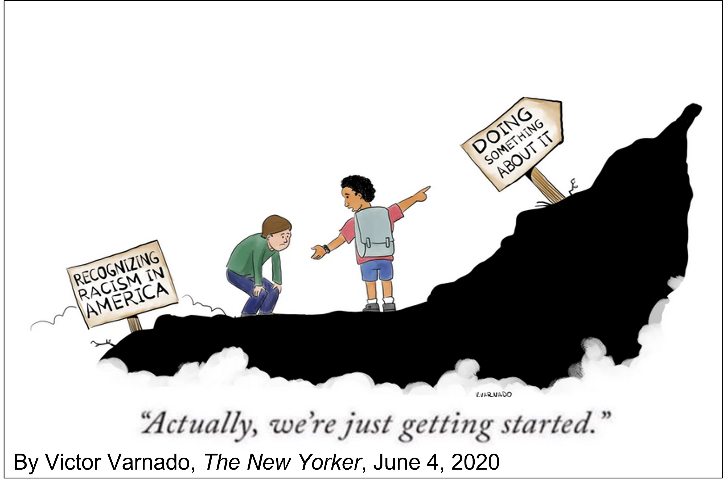Earlier this year, I was invited to talk about the ROOT & SHOOT project to a group of scientists. Although I was thrilled to have this opportunity, I had a few sleepless nights envisioning the possibility of angry outbursts from members of the audience. (I was preparing my talk at the same time as reading about legislation that criminalizes teaching about racism and LGBTQ+ discrimination; truly nightmarish times).
I decided that the best way to disarm potential challengers was to draw on the same tools we use to support our scientific talks, peer-reviewed research articles. I included references for each point I made in my presentation and prepared a printed reference list. Happily, there were no angry outbursts, but rather a thoughtful, open discussion about actions people can take towards positive cultural change.
I’m sharing these references (also available as a PDF) because I believe the articles can be useful to anyone who wants to talk with other scientists about systemic racism, ableism, and other barriers to inclusion. Sharing studies that show directly and vividly that practices accepted and common in the culture of science create a “hostile obstacle course” for people who experience significant intersections of oppression can counter opinions with facts (and who knows, maybe prompt skeptics to reconsider their views).
We also have a growing resource library here. Please get in touch if you’d like to contribute to it!
This list as a PDF can be downloaded here.
Evidence of inequity in STEM and beyond
Asai DJ (2020) Race Matters. Cell, 181:754–757. https://doi.org/10.1016/j.cell.2020.03.044
Berhe, AA et al. (2022). Scientists from historically excluded groups face a hostile obstacle course. Nature Geosci. 15:2–4. https://doi.org/10.1038/s41561-021-00868-0
Griffin, KA (2020). Institutional Barriers, Strategies, and Benefits to Increasing the Representation of Women and Men of Color in the Professoriate. In: Perna, L. (eds) Higher Education: Handbook of Theory and Research, vol 35. Springer, Cham. https://doi.org/10.1007/978-3-030-31365-4_4
Cech, E (2022) The intersectional privilege of white able-bodied heterosexual men in STEM. Sci Adv. https://doi.org/10.1126/sciadv.abo1558
Jones, CP (2000) Levels of racism: a theoretic framework and a gardener’s tale. Am. J. Public Health 90: 1212-1215. https://ajph.aphapublications.org/doi/abs/10.2105/AJPH.90.8.1212
Kendi, IX (2019) How To Be An Antiracist. One World Press. https://www.ibramxkendi.com/how-to-be-an-antiracist
Kent, AH and Ricketts LR (2020) Has wealth inequality in America changed over time? https://www.stlouisfed.org/open-vault/2020/december/has-wealth-inequality-changed-over-time-key-statistics
Lewis, N.A. What universities say versus do about diversity, equity and inclusion. Nat Hum Behav 6: 610 (2022). https://www.nature.com/articles/s41562-022-01339-1
Moss-Racusin CA, Dovidio JF, Brescoll VL, Graham MJ, and Handelsman J (2012) Science faculty’s subtle gender biases favor male students. Proc Natl. Acad Sci USA 109: 16474-16479. https://www.pnas.org/doi/10.1073/pnas.1211286109
McGee, EO (2020) Black, Brown, Bruised: How Racialized STEM Education Stifles Innovation. Harvard Education Press. https://www.hepg.org/hep-home/books/black,-brown,-bruised
McGee, E. O. (2020) Interrogating structural racism in STEM higher education. Ed. Res. 49: 633–644. https://doi.org/10.3102/0013189X20972718
Morgan, A.C., LaBerge, N., Larremore, D.B. et al. (2022) Socioeconomic roots of academic faculty. Nat Hum Behav 6: 1625–1633 https://doi.org/10.1038/s41562-022-01425-4
National Center for Science and Engineering Statistics (NCSES), Directorate for Social, Behavioral and Economic Sciences. National Science Foundation. https://nces.ed.gov/fastfacts/display.asp?id=61; and 2022 Diversity and STEM: Women, Minorities, and Persons with Disabilities.
National Academy of Sciences, National Academy of Engineering, and Institute of Medicine (2011) Expanding Underrepresented Minority Participation: America’s Science and Technology Talent at the Crossroads. Washington, DC: The National Academies Press. https://doi.org/10.17226/12984.
National Academies of Sciences, Engineering, and Medicine (2023) Advancing Antiracism, Diversity, Equity, and Inclusion in STEMM Organizations: Beyond Broadening Participation. Washington, DC: The National Academies Press. https://doi.org/10.17226/26803.
Scene on Radio (podcast) https://www.sceneonradio.org/
Wapman, K.H., Zhang, S., Clauset, A. et al. (2022) Quantifying hierarchy and dynamics in US faculty hiring and retention. Nature 610: 120–127 https://doi.org/10.1038/s41586-022-05222-x
White Supremacy Culture https://www.whitesupremacyculture.info/
Wingfield, AH (2020) Systemic racism persists in the sciences. Science 369: 351. https://www.science.org/doi/10.1126/science.abd8825
Wong, Alice.(2020) Disability Visibility: First-Person Stories from the Twenty-First Century. Knopf Doubleday. https://www.penguinrandomhouse.com/books/617802/disability-visibility-by-alice-wong/
What we can do
 A Progressive’s Style Guide https://www.resource-media.org/style-matters-sum-uss-new-progressive-style-guide/
A Progressive’s Style Guide https://www.resource-media.org/style-matters-sum-uss-new-progressive-style-guide/
Arif S, Massey MDB, Klinard N, Charbonneau J, Jabre L, et al. (2021) Ten simple rules for supporting historically underrepresented students in science. PLOS Computational Biology 17(9): e1009313. https://doi.org/10.1371/journal.pcbi.1009313
Cronin, M.R., Alonzo, S.H., Adamczak, S.K. et al. (2021) Anti-racist interventions to transform ecology, evolution and conservation biology departments. Nat Ecol Evol 5L 1213–1223 https://doi.org/10.1038/s41559-021-01522-z
Handelsman J et al. (2022) Achieving STEM diversity: Fix the classroom. Science 376: 1057-1059. https://www.science.org/doi/abs/10.1126/science.abn9515
Kimmerer, RW (2013) Braiding Sweetgrass. Milkweed Editions Press. https://milkweed.org/book/braiding-sweetgrass
Markle RS, Williams TM., Williams KS, deGravelles KH, Bagayoko D, Warner IM (2022) Supporting historically underrepresented groups in STEM higher education: The promise of structured mentoring networks. Frontiers in Education 7: 674669
Montgomery, B. (2021) Lessons from Plants. Harvard University Press. https://www.hup.harvard.edu/catalog.php?isbn=9780674241282
National Academies of Sciences Engineering, Medicine (2019) The Science of Effective Mentorship in STEMM. https://www.nationalacademies.org/our-work/the-science-of-effective-mentoring-in-stemm
National Academies of Sciences, Engineering, and Medicine (2023) Advancing Antiracism, Diversity, Equity, and Inclusion in STEMM Organizations: Beyond Broadening Participation. Washington, DC: The National Academies Press. https://doi.org/10.17226/26803.
Peña C, Ruedas-Gracia N, Cohen JR, Tran N, Stratton MB (2022) Ten simple rules for successfully supporting first-generation/low-income (FLI) students in STEM. PLOS Comp. Biol. 18(10): e1010499. https://doi.org/10.1371/journal.pcbi.1010499
Royal Society of Chemistry (2022) A sense of belonging in the chemical sciences. https://www.rsc.org/new-perspectives/talent/belonging-in-the-chemical-sciences/
Ruedas-Gracia N, Botham CM, Moore AR, Peña C (2022) Ten simple rules for creating a sense of belonging in your research group. PLOS Comp. Biol. 18(12): e1010688. https://doi.org/10.1371/journal.pcbi.1010688
Willis, LM, Mehta, D., and Davis, A (2020). Twelve principles trainees, PIs, departments, and faculties can use to reduce bias and discrimination in STEM. ACS Central Science 6: 2294-2300 https://pubs.acs.org/doi/pdf/10.1021/acscentsci.0c01120
0 Comments